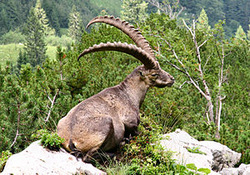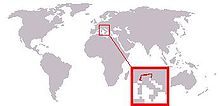Alpine Ibex
Facts
Also known as: Its names in various European languages are French - Bouquetin, Italian - Stambecco, Slovene - Kozorog, German - Steinbock, and Dutch - Steenbok.
Conservation Status: Least Concern.
Location: The Alps (mountain range in Slovenia, France, Germany,Switzerland, Italy, Austria, and Liechtenstein).
Lifespan: 10 to 18 years.
Also known as: Its names in various European languages are French - Bouquetin, Italian - Stambecco, Slovene - Kozorog, German - Steinbock, and Dutch - Steenbok.
Conservation Status: Least Concern.
Location: The Alps (mountain range in Slovenia, France, Germany,Switzerland, Italy, Austria, and Liechtenstein).
Lifespan: 10 to 18 years.
Scientific Classification
Kingdom: Animalia
Phylum: Chordata
Class: Mammalia
Order: Artiodactyla
Family: Bovidae
Genus: Capra
Species: C. Ibex
Binomial name: Capra Ibex
Kingdom: Animalia
Phylum: Chordata
Class: Mammalia
Order: Artiodactyla
Family: Bovidae
Genus: Capra
Species: C. Ibex
Binomial name: Capra Ibex
Description
Height: Male is about 1 metre (3 ft 3 in). Females usually about half the size of the male.
Weight: Male is about 100 kilograms (220 lb).Females usually about half the size of the male.
Coat: The Ibex has a brownish grey colouring in the summer which changes during the winter months to a richer, darker brown.
Other: Both male and female ibexes have large, backwards-curving horns although those of the male are substantially larger and can grow to an impressive length of up to 1 metre (3 ft 3 in).
Height: Male is about 1 metre (3 ft 3 in). Females usually about half the size of the male.
Weight: Male is about 100 kilograms (220 lb).Females usually about half the size of the male.
Coat: The Ibex has a brownish grey colouring in the summer which changes during the winter months to a richer, darker brown.
Other: Both male and female ibexes have large, backwards-curving horns although those of the male are substantially larger and can grow to an impressive length of up to 1 metre (3 ft 3 in).
Behaviour
They eat during late afternoon and evening hours, descending at this time from the high steep cliffs and into the lower alpine meadows below. The rest of the day is spent in the higher altitude of the cliffs and hills. This pattern of remaining at higher altitudes during the bright daylight hours helps protect them from predators who do not inhabit such high terrain. In the winter, Ibexes also tend to live at lower altitudes since food is more scarce. Male ibexes often group together in bachelor herds during summer; in late autumn, during rut, males typically go their own ways and seek out a female herd of their own.
They eat during late afternoon and evening hours, descending at this time from the high steep cliffs and into the lower alpine meadows below. The rest of the day is spent in the higher altitude of the cliffs and hills. This pattern of remaining at higher altitudes during the bright daylight hours helps protect them from predators who do not inhabit such high terrain. In the winter, Ibexes also tend to live at lower altitudes since food is more scarce. Male ibexes often group together in bachelor herds during summer; in late autumn, during rut, males typically go their own ways and seek out a female herd of their own.
Predators or Prey?
The Alpine Ibex's horns are used to defend themselves from predators such as Mountain Tigers,wolves, lynxes, bears and foxes. Young or baby Alpine Ibexes may also be susceptible to attacks from large predatory birds such as eagles.
The Alpine Ibex's horns are used to defend themselves from predators such as Mountain Tigers,wolves, lynxes, bears and foxes. Young or baby Alpine Ibexes may also be susceptible to attacks from large predatory birds such as eagles.
Diet
Ibexes are strictly herbivorous and survive on a diet of grass, moss, flowers, leaves and twigs. If leaves and shoots are out of reach, Ibexes often stand on their rear legs to reach this food. They eat during late afternoon and evening hours, descending at this time from the high steep cliffs and into the lower alpine meadows below. The need to drink every few days in the summer causes the Ibexes to seek permanent residence within proximity to a dependable water source during this season.
Ibexes are strictly herbivorous and survive on a diet of grass, moss, flowers, leaves and twigs. If leaves and shoots are out of reach, Ibexes often stand on their rear legs to reach this food. They eat during late afternoon and evening hours, descending at this time from the high steep cliffs and into the lower alpine meadows below. The need to drink every few days in the summer causes the Ibexes to seek permanent residence within proximity to a dependable water source during this season.
Habitat
Being an excellent climber, its habitat is the rocky region along the snowline above alpine forests of the European Alps. They tend to occupy steep, rough terrain at elevations of 6,500–15,000 feet (2,000–4,600 m).
Being an excellent climber, its habitat is the rocky region along the snowline above alpine forests of the European Alps. They tend to occupy steep, rough terrain at elevations of 6,500–15,000 feet (2,000–4,600 m).
Conservation
In 1856 King Emmanuel II of the Kingdom of Sardinia decided to allow no one but the royal family to hunt the few remaining Alpine Ibex, creating a game preserve in the Italian Alps, protected by dedicated gamekeepers.
Today, about 4,000 Alpine Ibex roam the area of the king's preserve, now the Gran Paradiso National Park. These, and all other Alpine Ibex are descendants of the animals from King Emmanuel's preserve, and are now protected by law.
In 1856 King Emmanuel II of the Kingdom of Sardinia decided to allow no one but the royal family to hunt the few remaining Alpine Ibex, creating a game preserve in the Italian Alps, protected by dedicated gamekeepers.
Today, about 4,000 Alpine Ibex roam the area of the king's preserve, now the Gran Paradiso National Park. These, and all other Alpine Ibex are descendants of the animals from King Emmanuel's preserve, and are now protected by law.
Reproduction
Male ibexes often group together in bachelor herds during summer; in late autumn, during rut, males typically go their own ways and seek out a female herd of their own. During breeding season, fight rituals occur between males in order to determine which is entitled to breed with the available females. Despite the large, heavy horns of the males playing a part in this ritual, it is rare that they are physically harmed in the process. After conception, and gestation period of 6 months, a single kid, meaning 'baby Alpine Ibex', is born around May. Twins are very rare to be born.
Male ibexes often group together in bachelor herds during summer; in late autumn, during rut, males typically go their own ways and seek out a female herd of their own. During breeding season, fight rituals occur between males in order to determine which is entitled to breed with the available females. Despite the large, heavy horns of the males playing a part in this ritual, it is rare that they are physically harmed in the process. After conception, and gestation period of 6 months, a single kid, meaning 'baby Alpine Ibex', is born around May. Twins are very rare to be born.



